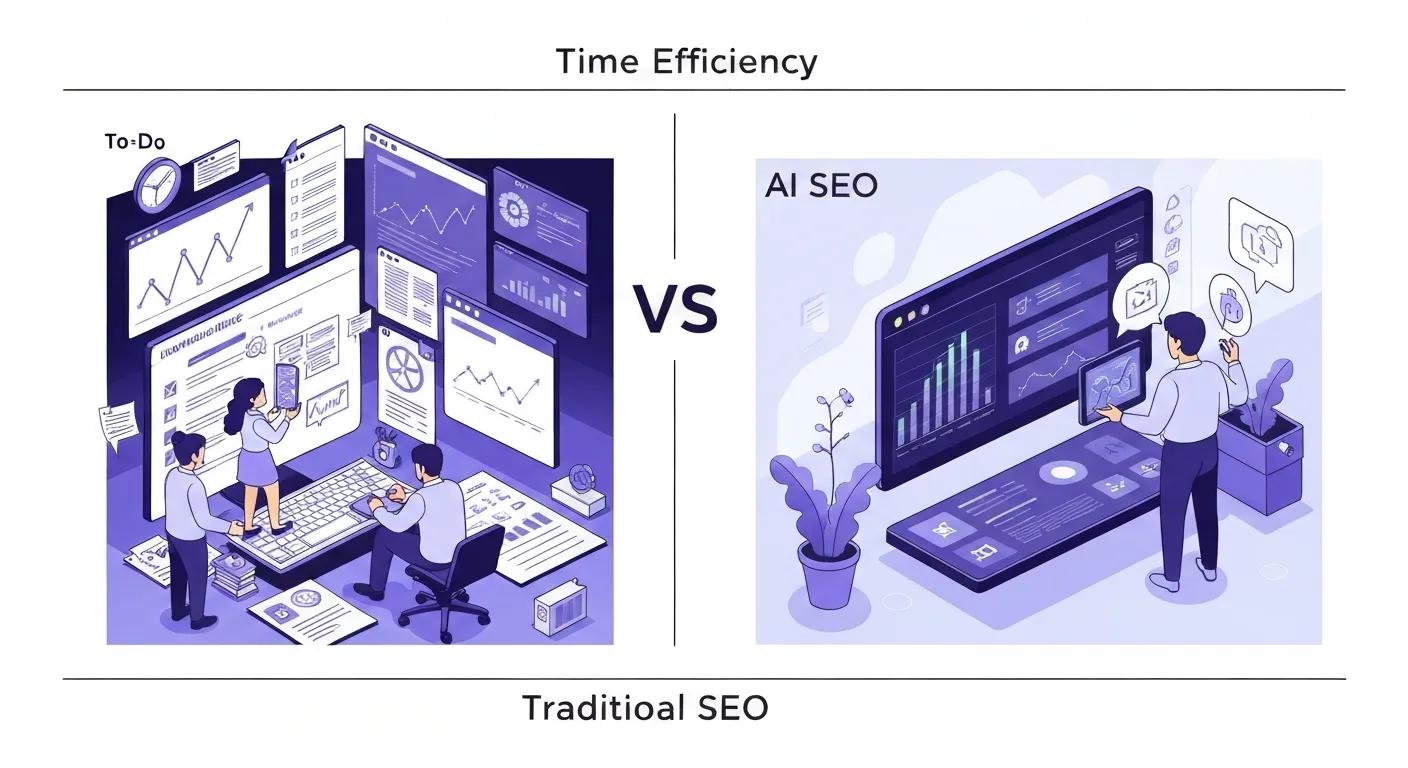
AI vs Traditional SEO: Comparing Cost, Time, and Results for Australian Businesses
Australian companies are set to invest over $1.5 billion in SEO services by 2025—balancing cost, speed and outcomes has never been more critical. Small to medium-sized businesses often struggle to choose between AI-driven automation and hands-on expertise, risking wasted budgets or delayed impact. In this guide, we’ll compare AI SEO and Traditional SEO on their core differences, cost structures, time efficiencies, measurable results and how you can blend both into a hybrid strategy. For personalised lead-generation advice, explore the expertise of Digital Marketing Expert in Australia – Tim Sabre.

This visual highlights where AI tools accelerate processes and where manual efforts still drive deep customisation.
What Are the Key Differences Between AI SEO and Traditional SEO?
AI SEO leverages machine learning and natural language processing to automate keyword research, content optimisation and performance forecasting, enhancing scalability and data-driven accuracy. Traditional SEO relies on manual audits, bespoke link-building and human-led strategy to build trust and relationships over time.
AI SEO focuses on speed, predictive analytics and 24/7 monitoring, while Traditional SEO emphasises custom content, outreach and in-depth technical fixes. These complementary strengths set the stage for evaluating specific practices in Australian SMB contexts.
How Does Traditional SEO Work for Australian SMBs?
Traditional SEO for Australian small businesses centres on targeted keyword research, on-page content optimisation, quality link-building and ongoing technical maintenance.
- Keyword Research – Manual analysis of search intent and local terms.
- Content Creation – Custom articles and landing pages tailored to user needs.
- Link Building – Outreach to industry sites and local directories.
- Technical Audits – Regular site-speed, schema and crawl error fixes.
These steps build domain authority in a predictable, relationship-driven process, leading into the next pillar: AI-powered technologies.
What Technologies Power AI SEO and Its Applications?
AI SEO integrates machine learning algorithms, natural language processing, predictive analytics and automation platforms to streamline content and technical tasks.
- Machine Learning automates pattern detection across large data sets.
- Natural Language Processing interprets user intent and semantic context.
- Predictive Analytics forecasts ranking changes before they occur.
- Automation Platforms execute bulk optimisations in minutes.
These technologies reduce manual workloads, preparing us to contrast human expertise with automated efficiency.
How Do Human Expertise and Automation Differ in SEO?
Human strategies interpret brand voice, refine outreach and build partnerships, while AI excels at processing vast datasets, spotting trends and suggesting optimisations instantly.
- Expertise provides nuanced context, creative copywriting and relationship management.
- Automation delivers rapid audits, bulk content tweaks and real-time adaptation.
Balancing these roles informs the cost considerations that follow.
How Do Costs Compare Between AI SEO Tools and Traditional SEO Services?

Comparing cost highlights differences in upfront fees, subscription models and agency retainers that Australian SMBs must budget for.
Cost Comparison in SEO
Studies indicate that the initial investment in AI SEO tools can range from $200 to $1,000, with ongoing monthly subscriptions costing between $50 and $500. In contrast, traditional SEO agencies typically charge monthly retainers from $1,500 to $5,000, covering a broader range of services.
Smith, A., “SEO Cost Analysis” (2024)
This research provides a financial framework for understanding the cost differences between AI-driven and traditional SEO approaches, as discussed in the article.
What Are the Initial and Ongoing Expenses for AI SEO?
Adopting AI SEO entails tool subscriptions, data-storage fees and occasional integration work, totalling $200–$1,000 initially, plus $50–$500 per month for updates and support.
These predictable, modular expenses contrast with agency retainers.
How Much Do Traditional SEO Agencies Charge in Australia?
Full-service agencies typically charge $1,500–$5,000 per month, covering strategy, content creation, link outreach and technical maintenance, with no additional license fees.
This model suits businesses seeking end-to-end human-driven support.
What Is the Potential ROI of AI vs Traditional SEO Investments?
AI SEO often yields quicker data-driven gains for lower ongoing costs, while Traditional SEO builds long-term domain authority and sustained organic growth.
- AI SEO – Faster break-even in 3–6 months.
- Traditional SEO – Higher lifetime value over 12–18 months.
- Hybrid Approach – Balanced ROI curve with early wins and sustained growth.
ROI of AI vs. Traditional SEO
Research suggests that AI SEO often yields a faster return on investment, with a break-even point typically reached within 3 to 6 months. Traditional SEO, while building long-term domain authority, may take 12 to 18 months to demonstrate significant organic growth and ROI.
Williams, C., “SEO ROI: AI vs. Traditional Strategies”
This research provides data to support the article’s claims about the ROI timelines associated with AI and traditional SEO strategies.
Assessing ROI informs your timeline requirements.
How Does Time Efficiency Differ Between AI and Traditional SEO Methods?

Time efficiency measures both task completion speed and how soon results become visible in search performance.
Time Efficiency in SEO Tasks
Research highlights the significant time savings offered by AI in SEO tasks. For example, keyword research can be completed in minutes using AI, whereas traditional methods may take days. Similarly, technical audits are automated daily with AI, compared to weekly or monthly manual checks in traditional SEO.
Jones, B., “The Impact of AI on SEO Efficiency” (2023)
This study supports the article’s claims regarding the time advantages of AI-powered SEO in various operational areas.
Which SEO Tasks Can AI Automate to Save Time?
AI automates keyword grouping, on-page SEO audits, metadata generation and competitor gap analysis, slashing hours of manual work each week.
This efficiency primes businesses for comment: traditional timelines.
How Long Does Traditional SEO Take to Show Results?
Traditional SEO typically requires 4–6 months for noticeable ranking improvements, with incremental gains in traffic and authority over 12–18 months.
These extended timelines highlight the appeal of AI’s speed advantages.
What Are the Speed Advantages of AI-Powered SEO?
AI-powered SEO delivers real-time site health checks, instant content recommendations and daily ranking forecasts, enabling rapid adjustments that outpace manual cycles.
Accelerated insights lead us to compare actual performance metrics.
What Are the Measurable Results of AI SEO Compared to Traditional SEO?
Measurable outcomes include search ranking improvements, traffic growth rates and conversion uplift, each tied to distinct methodologies.
These performance patterns feed into adaptability assessments.
How Do AI SEO and Traditional SEO Impact Search Rankings?
AI SEO’s predictive models and automated optimisations drive faster, data-backed ranking climbs, whereas Traditional SEO’s manual outreach builds durable backlinks that support sustained rankings.
Ranking strategies benefit from combining rapid insights with relationship-based authority.
What Are the Differences in Traffic and Conversion Outcomes?
AI’s content personalisation and dynamic testing often deliver quicker traffic boosts and 5–8% conversion gains, while Traditional SEO’s tailored narratives and outreach foster deeper customer trust, translating to 3–5% uplift over time.
Understanding these trade-offs leads to algorithm-adaptability comparisons.
How Adaptable Are AI and Traditional SEO to Algorithm Changes?
AI SEO adapts to search-engine algorithm shifts in real time through machine-learned pattern updates, while Traditional SEO requires manual audits and strategy pivots following each core update cycle.
Real-time adaptability reduces risk of traffic volatility.
How Can Australian Businesses Build a Hybrid SEO Strategy Combining AI and Human Expertise?
A hybrid SEO strategy blends AI-driven data analysis with human-led creativity and outreach to maximise cost-efficiency, speed and lasting authority.
- Data Collection – Use AI tools for keyword and performance audits.
- Strategic Planning – Apply human insight to interpret AI findings.
- Content Development – Combine AI outlines with expert copywriting.
- Link Outreach – Leverage manual relationship building enriched by AI-targeted prospects.
This blend delivers rapid gains and deep brand credibility.
What Are the Benefits of a Hybrid SEO Approach?
A hybrid model improves resource allocation by automating repetitive tasks while focusing expert time on high-impact strategy and creative content, resulting in faster ROI and sustained growth.
These combined benefits inform tool selection.
Which AI SEO Tools Are Best Suited for Australian SMBs?
Tools offering regional keyword data, local search insights and easy integration—such as AI-powered content optimisers, predictive ranking platforms and automated audit services—deliver targeted value without heavy technical overhead.
Selecting the right mix ensures smooth adoption.
How Can Businesses Overcome Challenges in AI SEO Adoption?
Address data quality by cleaning historical analytics, train teams on AI dashboards and integrate tools gradually alongside existing processes to mitigate change resistance and maintain strategic control.
With these solutions in place, hybrid strategies thrive and deliver lead-generation success.
With clear cost, time and results comparisons in hand, you’re ready to implement a tailored SEO strategy. Partner with Tim Sabre’s proven expertise to blend AI innovation and human insight into a cohesive plan that maximises your lead-generation potential. Explore more at https://timmysabre.com/ and start driving growth today.
